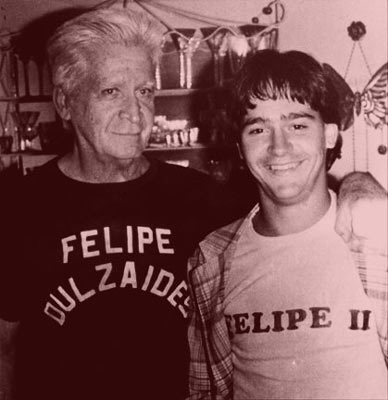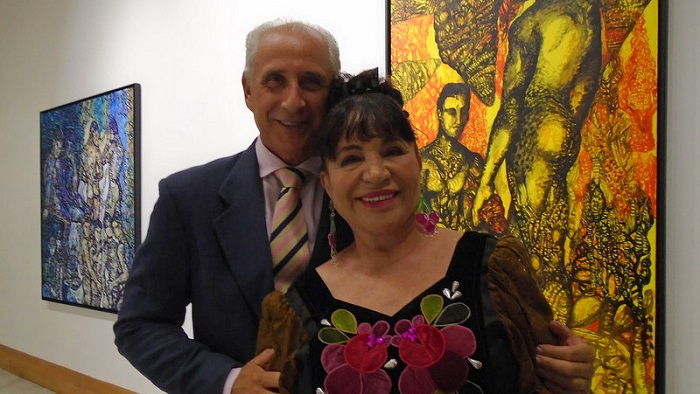By Berta Carricarte
That’s how, just as if I didn’t want to, I’ve asked some students from “Amadeo Roldan” conservatory, if they know Felipe Dulzaides: negative answer. Afterwards, I inquired about the Lupe and obtained the same result. Music does represent a huge and endless wealth, with vast historic dimension and variety, but forgiveness usually shrouds those spaces of past wealth, while the promotional negligence covers the mass media with improvised and belligerent “promises”. I was also taken away La Lupe; and Felipe Dulzaides was a barely recognizable name in the memory, mostly associated with the development of jazz in Cuba during the 1980s; and I heard Olga Guillot, when I was a child, from an old acetate that my father alternated with the privileged Beny; and so on, other artists were left behind, because now he is implacable, impatient and kind of deaf too.
Es tu nombre Felipe Dulzaides is the title of the program presented by Cuba French Alliance’s Salle Zéro between last November and December, putting together 5 of Felipe Dulzaides Jr.’s videos, obviously dedicated to the memory of his father. But, leaving aside what this tribute means for its creator from a personal point of view, I believe that there is a feedback connection among image, music and spectator. The biggest handicap of contemporary art –just like most of the artistic avant-gardism– is its transcendentalist airtightness in front of fortuitous receivers; however, that encrypting aspect, which can include significant and meanings, is its main source of joy for avid receivers, whether they are novices or connoisseurs. Es tu nombre… seems to take part of that fortune, until the minute when we give ourselves up to the sound experience, the sensorial heritage of music, universal as it is in its prose and melody. The five handpicked video-creations link together an aesthetic experience that goes from ecstasy to the effervescence, from drunkenness to irritation, from rapture to roughness, what also pays tribute to the curatorial hiladura of Andres D. Abreu.
What Salle Zéro exhibited represents an instant within the work of an artist whose creative wealth has been consolidated during the first decade of the ongoing century. Graduated in 1989 in Theater, Dulzaides possesses a vast video-graphic work that has been mostly created and exhibited in the international stage, making up personal and collective exhibitions, as well as national spaces (Ludwig Foundation, National Museum of Fine Arts and Salle Zéro in 2007). This author’s work is characterized by its capacity when it comes to turning poetic, dramatic, photographic and musical speculations into converging universes, without compromising the coherence of the artistic exercise.
In this exhibition, music and image open a dialogue in which the supra-textual plays the leading role. The blood potential of both registers (music and image) gets multiplied by levels of memory, yearning of the simple fascination of the most modest receivers, even if they have never heard or seen anything related to that or this Felipe Dulzaides.
 Therefore, allow me to introduce this brief memorandum: in 1955 Felipe Dulzaides Badia founded a vocal-instrumental quartette, named Los Armonicos, which once included, among others, Frank Emilio and Bebo Valdes, as well as international figures, and made history in cabarets such as Sans-Souci, Montmartre, Tropicanaand many others. In the late 1950s, Dulzaides worked as arranger for La Lupe’s famous disc, Con el Diablo en el cuerpo, and did the same for the bolero singer Fernando Alvarez. With a declared vocation for jazz, an anti-academic mastery of piano, an exceptional talent for composition and almost 22 discs recorded during his career, he is one of the most important musicians that have born in this Island. And though he was posthumously awarded a Cubadisco prize in 2001 for his Tabú album, there is still a lot to be discovered and enjoyed in terms of this Felipe Dulzaides.
Therefore, allow me to introduce this brief memorandum: in 1955 Felipe Dulzaides Badia founded a vocal-instrumental quartette, named Los Armonicos, which once included, among others, Frank Emilio and Bebo Valdes, as well as international figures, and made history in cabarets such as Sans-Souci, Montmartre, Tropicanaand many others. In the late 1950s, Dulzaides worked as arranger for La Lupe’s famous disc, Con el Diablo en el cuerpo, and did the same for the bolero singer Fernando Alvarez. With a declared vocation for jazz, an anti-academic mastery of piano, an exceptional talent for composition and almost 22 discs recorded during his career, he is one of the most important musicians that have born in this Island. And though he was posthumously awarded a Cubadisco prize in 2001 for his Tabú album, there is still a lot to be discovered and enjoyed in terms of this Felipe Dulzaides.
I would say that what his son gave us is the sign of a treasure and a subtle call to the memory or the unveiling. The first video expresses, in visual terms, a strong contrast between the foreignly urban (Copenhagen as background) and the natural, in the presence of a tree trunk with a surface that projects the kaleidoscopic light of a CD, while we listen to Tu rostro en la penumbra, piano arranged and played by the mentioned musician; and his son’s whistle has been incorporated. Two elements are introduced here, which are to be substantial in the following videos: from an artistic point of view the dialogue with textures and from the poetic viewpoint the tree metaphor or, let’s say, the tree trunk, which as clear metonymy puts branches and roots aside. The chromatic wealth, hidden in the cold and sentimentally neutral surface of aluminum, faces the rough harshness of the plant, which also contrasts with the polished bottom of concrete, with the same paradoxical taste that entails taking in the artistic wealth contained in that shinny and circular sheet.
Afterwards, there is one shot that displays two strong diagonal lines between which the character moves, looking for the scape point – behind the impossible order of a tree trunk turned into firewood–, with a ludic swaying between stumps, while years pass by, so the image of the son has already reached the photographic age of the father, when he collated the electrifying disproportions of La Lupe. Back to the contrast, now between the mature temperance of the musician, a gentle and calm man, and the hormonal turbulence of the queen of Latin soul, Guadalupe Victoria Yoli, whose temperamental image slithers fragmented and recomposed at white heat. Together in that old picture, the girl and the gentleman, through the microphone, get on their arts and seem to get their breath back, while the audiovisual manipulation adds the whimsical geometry with color and shape, which boosts and skyrockets the diva’s music and voice to another dimension.
There is a moment when the tree trunk metaphor is joined (or contrasted?) by the crawling scroll within the gray tunnel, perhaps expressing associations beyond the pure remembrance and proposing a dense contrast between the unidirectional aspect represented by the tunnel and the pirouette and ductile wealth of human spirituality. As I see it, I find pretty easy to fit the image of this scroll in the image of typical Japanese kimonos, which used to include in those ancient times collections of fables, mythology and novels, combining calligraphy and painting, and nowadays represent authentic tradition reservoirs. Nevertheless, I think that the artist must be careful with certain suggestions that follow the nature and function of some objects. It’s all about trying to avoid the appreciation and exegesis of trope to become spectators into a mental battle when they try to put aside interpretations that don’t fit in the emotional and aesthetic context around the artistic speech, which, in this case, could have been avoided by not making recognizable the nature of the scroll in the implacable rudeness of the close-up; especially if what we are listening to is As time goes by, which always takes us back to the love story that was told before and after Casablanca.
The following theme features Pagina en blanco as musical benchmark, sung by Fernando Alvarez, whose melodic vocal seasoning is added to the contrast effects between the paving of an ancient city and the fluvial surface that shelters the old metropolis’ luminous nocturnality. Images that reflect nostalgia in a broad and versatile sense, a sort of yearning on the bright and icy waters and the anonymous comings and goings of pedestrians.
Finally, the cliffhanger, the catharsis, the effervescence, a ship launching, the detachment of steel, the delivery, the light, the explosive verticality of the phallus, the galactic semen, just like a recognition of the visceral and genetic legacy of creation. An image that has been seen a thousand times now becomes a subverted referent with lucid suggestion, excited by La danza ritual del fuego, by Manuel de Falla.
Just like the tangentialness of an imminently pictorial art obliges, almost pushes, to talk about styles and trends, the video-creation usually puts the image apart the compulsory report and invites to the enthusiastic and analytical contemplation, the academic and meditative look or the chimerical adventure, as well as interpretations that are always fortuitous and supreme. This free condition beats in Felipe Dulzaides’ proposal, which with the tactile turgidness of its images and the reconstitution of its allegories minimizes the forgiveness and anchors the consent, the memory.
Source: Cubarte
Related Publications











